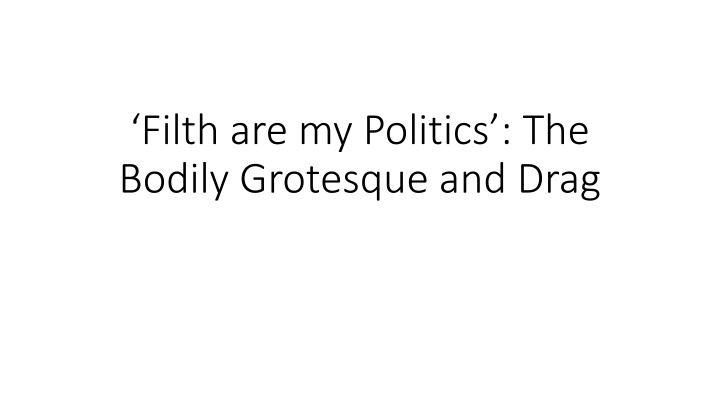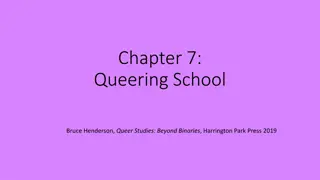Celebrating Queerness Through Filth and Drag
The self-identification of LGBTQ+ individuals has evolved globally, with drag emerging as a powerful form of expression. Drag challenges heteronormativity, celebrates queerness, and addresses significant psychological and political themes. The grotesque nature of drag redefines queer corporeality amidst the backdrop of the AIDS pandemic. Ultimately, drag serves as a political and celebratory medium, reshaping societal perceptions and promoting acceptance of queer identities.
Download Presentation

Please find below an Image/Link to download the presentation.
The content on the website is provided AS IS for your information and personal use only. It may not be sold, licensed, or shared on other websites without obtaining consent from the author.If you encounter any issues during the download, it is possible that the publisher has removed the file from their server.
You are allowed to download the files provided on this website for personal or commercial use, subject to the condition that they are used lawfully. All files are the property of their respective owners.
The content on the website is provided AS IS for your information and personal use only. It may not be sold, licensed, or shared on other websites without obtaining consent from the author.
E N D
Presentation Transcript
Filth are my Politics: The Bodily Grotesque and Drag
In the period of less than a century the self-identification of gays and lesbians [ ] has moved from a covert and localized practice aimed at mutual recognition to a global phenomenon with encompassing political issues. Marjorie Garber, Vested Interests: Cross-Dressing and Cultural Anxiety (New York: Routledge, 1992) pp. 2-3 Drag is the simultaneous mockery of heteronormativity and celebration of queerness
Drag is a highly adaptable form []that addresses powerfully, if on occasion simplistically, topics of major psychological and political significance to lesbians and gay men alike. Paulina Palmer, The Queer Uncanny: New Perspectives on the Gothic (Cardiff: University of Wales Press, 2012) p. 25 the grotesque ignores the impenetrable surface that closes and limits the body as a separated and completed phenomenon. Mikhail Bakhtin, the Grotesque Image of the Body and its Sources , in The Body: A Reader, ed. Mariam Fraser and Monica Greco (New York & London: Routledge, 2005) p. 93
http://s1.dmcdn.net/AUjb4.jpg http://nyc.wpengine.netdna-cdn.com/wp-content/uploads/2016/04/RPDRS4E125.jpg
http://scontent.cdninstagram.com/t51.2885-15/s480x480/e35/c126.0.828.828/15876801_112323825943690_4662863470042021888_n.jpg?ig_cache_key=MTQyOTI0NjIxNTcwMzU2NzM2MQ%3D%3D.2.chttp://scontent.cdninstagram.com/t51.2885-15/s480x480/e35/c126.0.828.828/15876801_112323825943690_4662863470042021888_n.jpg?ig_cache_key=MTQyOTI0NjIxNTcwMzU2NzM2MQ%3D%3D.2.c
the AIDS pandemic has made the body the gay male an object of massive public curiosity by representing it as a site of mysterious and fatal infections . Palmer, citing Emmanuel S. Nelson, in The Queen Uncanny, p. 45 Grotesque drag takes the imbrication of death and disease on the gay male body as a result of the AIDS crisis and repurposes it.
Conclusions The political elements of drag are prevalent across drag aesthetics. The performance of stereotypes in ways that deviate from intended hetero-patriarchal/heteronormative power is indicative of this. Filth acts as a method of renegotiating queer corporeality by performing death and disease I think. Drag is a celebratory medium, promoting and forcing hetero-patriarchal subjects to acknowledge the present of queer individuals and queer art/culture. So, even filthy, grotesque drag is in some way celebrating queerness. Always already other to itself, it offers a celebratory new Gothic subject, one in which horror is regenerative. Catherine Spooner, Post-Millennial Gothic: Comedy, Romance and the Rise of Happy Gothic (London: Bloomsbury, 2017) p. 176























